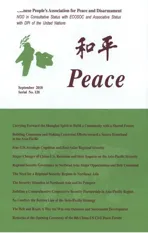The Security Situation in NortheastAsia and its Prospect
2018-12-13BySangHyunLEE
By Sang Hyun LEE
Senior Research Fellow,the Sejong Institute,ROK
1.Evaluating the U.S.-DPRK Singapore Summit
Finally,U.S.President Donald Trump and North Korea’s Chairman Kim Jong-un met for a historic summit on June 12 in Singapore.The summit was indeed a ‘historic’in the sense that the leaders of two enemy states met for the first time face-to-face.
The Singapore summit reached on four agreements: establishing new US-DPRK relations;building a lasting and stable peace regime on the Korean Peninsula;reaffirming the April 27,2018 Panmunjom Declaration,the DPRK commits to work toward complete denuclearization of the Korean Peninsula;recovering POW/MIA remains,including the immediate repatriation of those already identified.
In this statement,there’s no mentioning about the denuclearization time frame,inspection and verification procedures.
This indicates that there will be a series of long and arduous follow-up negotiations between the U.S.and DPRK negotiation teams.In fact,U.S.Secretary of State Mike Pompeo has visited Pyongyang for the third time,apparently with little progress.Most U.S.media analyzed that Pompeo’s visit will be a real test of whether Kim is serious about denuclearization or not.After his visit,however,we have very conflicting messages.North Korea accused the U.S.of“gangster-like tactics” and increasing the “risk of war,”whereas Pompeo said that the two sides had“good-faith,productive conversations which will continue in the days and weeks ahead.”
Given North Korea’s reaction after Pompeo’s third visit,denuclearization progress looks quite uncertain.The divergent accounts demonstrated the difficulty in translating the broad goal of denuclearization on the Korean Peninsula that resulted from Trump-Kim summit into specifics that would be acceptable to both sides.
2.Building a Peace Regime on the Korean Peninsula:Issues and Hurdles
From South Korea’s perspective,building a permanent peace regime on the Korean Peninsula is a long-cherished goal even before the nuclear crisis has begun.The Korean War came to a halt on July 27,1953,when the commander-in-chief,United Nations Command(CINCUNC,a four-star U.S.general),on the one hand,and the supreme commander of the Korean People’s Army and the commander of the Chinese People’s Volunteers,on the other hand,signed the Korean War Armistice Agreement.Since then,the peace on the Korean Peninsula has been based on temporary halt of violence rather than on a peace treaty,meaning all parties involved technically remain at war.
A peace regime on the Korean Peninsula consists of a complete denuclearization and security guarantee toward the DPRK,officially ending the Korean War(terminating the cease-fire treaty),and a permanent peace treaty.North Koreans have consistently claimed that they developed nuclear weapons because of U.S.hostile policy against them.Hence,the key to denuclearization was that the United States had to end its “hostile policy,”stopping political,security,and economic confrontation in return for eliminating their nuclear weapons.
The political aspect comprises U.S.recognition of North Korea as a sovereign state through establishing diplomatic relations between North Korea and surrounding countries,including South Korea and the United States;the security/military aspect includes officially ending the state of war on the Korean peninsula by replacing the temporary armistice agreement with a permanent peace treaty,and stop using—or threatening to use—strategic assets against North Korea;the economic aspect includes lifting trade restrictions and sanctions imposed on the North over the decades since the Korean War by both the United States and UN Security Council.
In light of North Korea’s condition for terminating U.S.hostile policy toward them,it can be a meaningful interim steps to consider a declaration to end the Korean War as a part of security guarantee, including US-DPRK non-aggression pledge.Declaration itself is an agreement,not a treaty.Hence it can be a symbolic step moving toward a peace treaty between the U.S.and North Korea.
Taking one step further,a peace regime should be better endorsed by international institutional support,either by a multilateral security consultative mechanism, or an involvement of international financial organizations.And,of course,a peace regime on the Korean peninsula should proceed in parallel with the actual progress in implementing the denuclearization process.
3.Remaining Issues
As peace regime proceeds,the status and role of ROK-U.S.alliance,the USFK,UNC and its future will be a controversial issue between South Korea and the United States.U.S.President Trump already declared that U.S.and South Korea will stop joint military drills,as far as the negotiation continues.
A question is the actual cost associated with dismantling North Korea’s nuclear weapons and facilities.Who will bear the cost of denuclearizing North Korea?Will South Korea,Japan,and China pay the cost as President Trump wishes?
The future ahead is like a complex three-dimensional game.On the inter-Korean dimension, genuine rapprochement and improvement of the relationship should be discussed;on the U.S.-North Korea dimension,both leaders should come up with a detailed plan to exchange CVID and provide a regime security guarantee; on the North Korea-international community dimension,lifting sanctions and verification/monitoring mechanism must be discussed.Progress on these three dimensions should proceed in tandem,roughly in a balanced pace.This will give a better chance to finish North Korea’s nuclear crisis once and for all.
杂志排行
Peace的其它文章
- Regional Security Governance in NortheastAsia:Major Opportunities and their Command
- CPAPD International Exchanges
- The Need for a Regional Security Regime in NortheastAsia
- Major Changes of China-U.S.Relations and their Impacts on the Asia-Pacific Security
- Sino-U.S.Strategic Cognition and EastAsian Regional Security
- Remarks at the Closing Ceremony of the 8th China-US Civil Peace Forum
